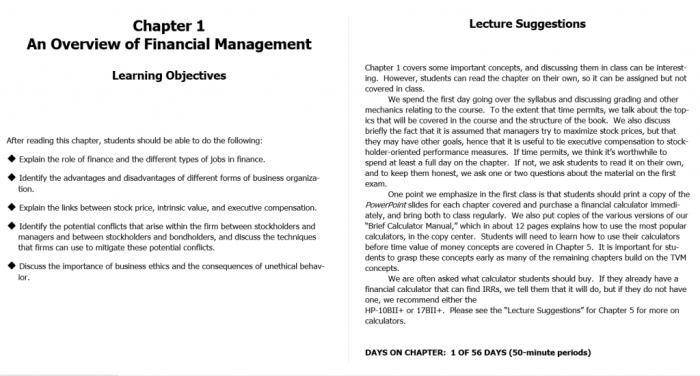In the realm of business operations, financial management stands as a cornerstone, shaping strategic decisions and ensuring financial stability. Fundamentals of Financial Management 15th Edition unveils the intricacies of this discipline, providing a comprehensive guide to the principles, practices, and techniques that drive financial success.
Through a blend of theoretical foundations and practical applications, this esteemed text empowers financial managers with the knowledge and skills necessary to navigate the complexities of the financial landscape. From financial analysis and planning to capital budgeting and investment analysis, the book delves into the core concepts that underpin sound financial decision-making.
1. Introduction

Financial management is the process of planning, organizing, directing, and controlling financial resources to achieve the objectives of a business. It is a critical function that helps businesses to maximize their profitability, minimize their risk, and make sound financial decisions.
Financial managers play a vital role in the decision-making process of a business. They provide financial analysis, advice, and recommendations to help management make informed decisions about capital budgeting, investment, and other financial matters.
The key concepts and principles of financial management include:
- Time value of money
- Risk and return
- Capital budgeting
- Cost of capital
- Capital structure
- Working capital management
- Long-term financing
- Dividend policy
- Financial risk management
2. Financial Analysis and Planning
Financial analysis is the process of evaluating a company’s financial performance and position. It involves using financial ratios, cash flow analysis, and other techniques to assess a company’s profitability, liquidity, and solvency.
Financial planning is the process of developing a financial roadmap for a business. It involves setting financial goals, identifying the resources needed to achieve those goals, and developing strategies to manage financial risk.
Budgeting is a critical part of financial planning. It involves allocating financial resources to different areas of a business to achieve its objectives.
Techniques of Financial Analysis
- Ratio analysis
- Cash flow analysis
- Break-even analysis
- Sensitivity analysis
3. Capital Budgeting and Investment Analysis
Capital budgeting is the process of evaluating and selecting long-term investments. It involves using capital budgeting techniques, such as payback period, net present value, and internal rate of return, to assess the profitability and risk of different investment opportunities.
Investment analysis is the process of evaluating the potential return and risk of an investment. It involves considering factors such as the investment horizon, the expected rate of return, and the level of risk tolerance.
Factors to Consider When Evaluating Investment Opportunities
- The size and nature of the investment
- The expected rate of return
- The level of risk
- The investment horizon
- The tax implications
4. Cost of Capital and Capital Structure: Fundamentals Of Financial Management 15th Edition
The cost of capital is the rate of return that a company must pay to its investors for the use of their funds. It is a critical factor in financial decision-making, as it affects the profitability of a company’s investments.
Capital structure is the mix of debt and equity financing that a company uses to finance its operations. It affects the cost of capital and the risk of a company.
Factors that Influence a Firm’s Optimal Capital Structure
- The size and nature of the business
- The industry in which the business operates
- The company’s financial condition
- The company’s growth prospects
- The cost of debt and equity financing
5. Working Capital Management
Working capital management is the process of managing a company’s short-term assets and liabilities. It involves optimizing the level of inventory, accounts receivable, and accounts payable to maximize profitability and minimize risk.
Strategies of Working Capital Management, Fundamentals of financial management 15th edition
- Inventory management
- Accounts receivable management
- Accounts payable management
6. Long-Term Financing
Long-term financing is the process of raising funds for a period of more than one year. It involves issuing bonds, stocks, or other forms of long-term debt or equity.
Types of Long-Term Financing
- Bonds
- Stocks
- Private placements
- Venture capital
7. Dividend Policy
Dividend policy is the process of determining how much of a company’s earnings will be paid out to shareholders in the form of dividends.
Factors that Influence Dividend Decisions
- The company’s earnings and cash flow
- The company’s investment opportunities
- The company’s tax situation
- The expectations of shareholders
8. Financial Risk Management
Financial risk management is the process of identifying, assessing, and mitigating financial risks. It involves using a variety of techniques, such as hedging, diversification, and insurance, to reduce the impact of financial risks on a company.
Types of Financial Risks
- Credit risk
- Interest rate risk
- Foreign exchange risk
- Commodity price risk
9. Ethics and Corporate Social Responsibility in Financial Management
Ethics and corporate social responsibility are important considerations in financial management. Financial managers must make decisions that are not only financially sound, but also ethical and socially responsible.
Ethical and Socially Responsible Financial Management Practices
- Avoiding conflicts of interest
- Treating all stakeholders fairly
- Investing in socially responsible projects
- Promoting diversity and inclusion
FAQ Corner
What is the significance of financial management in business operations?
Financial management plays a critical role in ensuring the financial health and sustainability of businesses. It involves planning, organizing, directing, and controlling financial resources to achieve organizational goals, such as profitability, growth, and solvency.
What are the key concepts covered in Fundamentals of Financial Management 15th Edition?
The book covers a wide range of topics, including financial analysis, planning, capital budgeting, cost of capital, working capital management, long-term financing, dividend policy, and financial risk management.
How does Fundamentals of Financial Management 15th Edition help financial managers make better decisions?
The book provides a comprehensive framework for financial decision-making, equipping managers with the knowledge and tools to evaluate investment opportunities, manage financial risk, and optimize the use of financial resources.